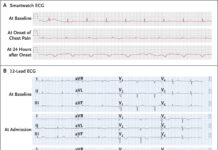Case Presentation
A 61-year-old man from Western Europe presented to the neurological outpatient clinic due to persistent issues. He reported swelling in his hands for the past 8 weeks and myalgia in the lower and upper limbs linked to physical activity over the last 3 months. Moreover, he was experiencing general muscular weakness and a hoarse voice without difficulty swallowing. The clinical neurological examination revealed mild dysarthria, bilateral calf muscle hypertrophy without tenderness on palpation, and pall hypesthesia in the lower limbs. Additionally, the patient complained of paraesthesia in the first three fingers and the radial fourth finger of his right hand. The positive Phalen’s sign indicated potential carpal tunnel syndrome.
Examination
Aside from mild limb edema, his cardiovascular and respiratory systems showed no abnormalities. Notably, creatine kinase (CK) levels were significantly elevated at 64 µmol/l*s (normal < 3.2), and electromyography (EMG) revealed spontaneous activity (positive sharp waves and fibrillation potentials) in the muscles (right tibialis anterior and left gastrocnemius) without signs of chronic denervation or myopathic changes.
Investigations
Subsequently, doctors admitted the patient to the neurological ward. A nerve conduction study confirmed bilateral carpal tunnel syndrome, but no signs of polyneuropathy were present. Magnetic-evoked potentials were within normal limits. There was an elevated thyroid-stimulating hormone (TSH) level, reaching 30.5 mU/l (normal range: 0.27–4.20 mU/l), with T3 levels below 1.50 pmol/l (normal range: 3.10–6.80 pmol/l). His T4 levels were under 1.30 pmol/l (normal range: 12.00–22.00 pmol/l). Consequently, we diagnosed manifest hypothyroidism. Anti-thyroglobulin antibodies (5671.0 U/ml, normal < 60 U/ml) and anti-TSH-receptor antibodies (5.4 U/ml, normal < 1.8 U/ml) were elevated, leading to the diagnosis of Hashimoto thyroiditis. Myoglobin levels were elevated at 248 µg/l (normal range 28–72 µg/l). The blood count indicated a mild normocytic, normochromic anaemia and liver enzymes (ALAT up to 1.94 µmol/ls, ASAT up to 2.75 µmol/ls, both normal < 0.83 µmol/ls and < 0.85 µmol/ls, respectively). Renal function exhibited no significant abnormalities, and cerebrospinal fluid showed cytoalbuminologic dissociation without signs of infection. Rheumatologic parameters, hepatitis serology, lipid profile, and vitamins revealed no pathological findings.
An electrocardiogram, cardiac ultrasound, and pulmonary function testing revealed no abnormalities. Magnetic resonance imaging displayed muscular hypertrophy in the lower limbs, excluding myositis or myopathy.
Management
Consequently, doctors initiated replacement therapy with levothyroxine (LT4) at a daily dose of 75 µg. Myopathic symptoms showed improvement over six months, though complete remission did not occur. Bilateral calf hypertrophy persisted, and EMG indicated signs of chronic denervation with elevated amplitudes of muscle unit action potentials (right and left tibialis anterior, left gastrocnemius muscles). The positive sharp waves persisted in the right tibialis anterior muscle. Muscle ultrasound revealed normal to slightly increased echogenicity of the calf muscles (Fig. 1C). The patient reported a satisfactory clinical recovery of muscle strength and reduced myalgia. CK and myoglobin levels significantly decreased.
Hoffmann’s Syndrome
The thyroid hormone plays a crucial role in the cellular metabolism of all human organic systems. Among the common malfunctions of the thyroid gland is primary hypothyroidism, often associated with a rare muscular manifestation known as Hoffmann’s syndrome in adults. It is called Kocher-Debré-Sémélaigne syndrome in children. Hoffmann’s syndrome is characterized by a distinctive weakness of limb muscles, particularly in the proximal regions. It is accompanied by an increase in muscle mass (pseudohypertrophy), muscle stiffness, and cramps. This condition predominantly affects male adults with longstanding untreated hypothyroidism and muscular pseudohypertrophy.
In addition to classic hypothyroidism symptoms like somnolence, cold intolerance, depressed mood, and myxedema, individuals with Hoffmann’s syndrome may experience muscular symptoms such as exercise intolerance, myalgia, cramps, stiffness, and myoedema. Hypothyroidism is known to be associated with impairments in peripheral nerves, neuromuscular junctions, and muscular fibres.
A key indicator of hypothyroid myopathy (HM) is the simultaneous elevation of thyroid-stimulating hormone (TSH) and either creatine kinase (CK) or lactate dehydrogenase (LDH) for a minimum of two weeks. Hashimoto thyroiditis is the primary cause of HM.
The underlying pathophysiology of Hoffmann’s syndrome remains uncertain. However, one potential mechanism involves an alteration of glycogen metabolism and oxidative phosphorylation in the muscle. Thyroid hormone T3, a major hormonal regulator of glucose metabolism in the skeletal muscle mitochondria, is reduced in patients with hypothyroidism. This results in decreased glycogenolytic activity in the muscles. This is evident through low levels of acid alpha-glucosidase in muscle cells and the accumulation of glycogen deposits. Additionally, hypothyroidism leads to atrophy and loss of type 2 muscle fibres (fast twitch and fast contraction fibres) and hypertrophy of type 1 fibres (slow twitch and slow contraction fibres). Another mechanism involves changes in glycosaminoglycan metabolism due to increased urinary excretion of glycosaminoglycans in hypothyroid patients.
Conclusion: Hoffmann’s Syndrome
The standard treatment for HM involves replacement therapy with thyroid hormone (LT4). However, complete clinical recovery may not be achieved in some patients, and persistent myopathic symptoms can endure for years. The response to LT4 treatment varies, depending on the severity of previous muscle damage and the patient’s age.
Hoffmann’s syndrome is characterized by distinctive clinical features, including muscular weakness, pseudohypertrophy of the calf muscles, and elevated levels of creatine kinase (CK) and thyroid-stimulating hormone (TSH). The use of electromyography (EMG) is effective in identifying muscle involvement, while muscle MRI aids in distinguishing Hoffmann’s syndrome from other myopathies. This rare myopathy is linked to hypothyroidism, contributing to the differential diagnosis of myopathic complaints, even in cases where hypothyroidism has not been previously diagnosed. The combination of these clinical markers and diagnostic tools plays a crucial role in identifying and understanding Hoffmann’s syndrome within the spectrum of muscle-related conditions.




